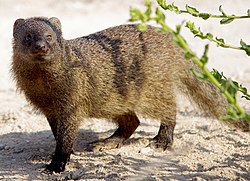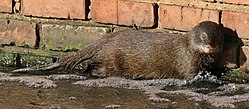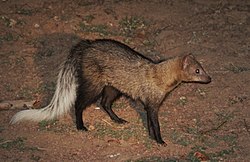| Mongoose | |
|---|---|
 | |
| Top left: Meerkat Top right: Yellow mongoose Bottom left: Slender mongoose Bottom right: Indian gray mongoose | |
| Scientific classification | |
| Kingdom: | Animalia |
| Phylum: | Chordata |
| Class: | Mammalia |
| Order: | Carnivora |
| Superfamily: | Herpestoidea |
| Family: | Herpestidae Bonaparte, 1845 |
| Type genus | |
| Herpestes | |
| Genera [1] | |
 | |
| Synonyms [1] | |
List
| |
A mongoose is a small terrestrial carnivorous mammal belonging to the family Herpestidae. This family has two subfamilies, the Herpestinae and the Mungotinae. The Herpestinae comprises 23 living species that are native to southern Europe, Africa and Asia, whereas the Mungotinae comprises 11 species native to Africa. The Herpestidae originated about 21.8 ± 3.6 million years ago in the Early Miocene and genetically diverged into two main lineages between 19.1 and 18.5 ± 3.5 million years ago. There is a large introduced population on the islands of Hawaii. Mongoose diets are varied but consist of mainly insects, hatchlings, reptiles and birds.













